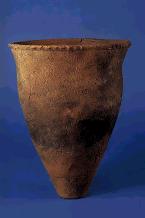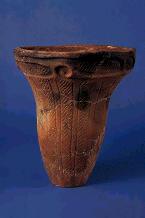 Jomon pottery
Jomon pottery Jomon pottery
Jomon pottery
The most ancient Japanese pottery was made
about 14,500 BC, that is the most ancient
in the world. (The C14 analysis result of
a pottery excavated in northern part of Japan
was reported 1999/4).
Do you think, " Pottery was invented
somewhere in Asia. Japanese in Jomon period
just imitated it. As for the culture/civilization
of Japan, they had no originality."?
It seems to be wrong. They might have had
the most advanced technology in the world.
Unglazed pottery from which water does not
leak
I had thought that water must leak when a Jomon pottery was used to boil anything, because it is unglazed. I had thought that such as starch plugs the pore of potery and stops leaking after it was used to cook several times. I had thought that only the designs of Jomon pottery progressed. However the fact differs. I should have praised the technology of inside structure of Jomon pottery. When the pottery is manufactured from "soil", its inside is polished at the middle of drying process to make density high by applying pressure with finger or shell etc. The countermeasure to water leak was set up. The baking method also seems to be devised. As for Jomon pottery, water leak does not break out even the unglazed pottery.
About half of the Jomon pottery are for cooking.
If they cooked with leaked pottery, it is
unable to heat the temperature of the pottery
contents up to 90 degrees C, by the evaporation
heat of the moisture. Jomon people tilt all
the omniscience on pottery and seem to have
manufactured an excellent functional pottery.
Is the contemporary ceramic art house able
to make the unglazed leakless pottery only
with soil and baking method?
Selection of "soil"
Jomon pottery is not made only with clay.
Sand or soil having larger particle size
is mixed with clay. Actually I dug clay at
a cliff near my home, and have bedaubed the
clay inside of a furnace to make anti-heat
layer. As clay dried, cracks occurred a lot
and could not bake. I recalled that we made garden furnace under the guidance
of my mother, when I was in junior high school.
We mixed the red soil with clay and applied
it inside of furnace, dried, burnt. A culture
must be linked like this.
Fine clay must be selected. The mixing soil
must be selected too. Mixed clay and soil
must be kneaded well, and laid for a determined
time. It is resulted by analysis that Jomon
pottery excavated in Chiba City contains
soils of the different region. It is such
a case that the mica is used as soil. Mica
can not mine in Chiba City.
Use of lacquer
The lacquered ware is said that its technology
was introduced from the continent. But there
are the Jomon potteries that are applied
lacquer in Japan, The application of lacquer
might have begun in Japan. Or, the culture
in Japan was discontinued.
In the beginning of Jomon period, the Jomon
pottery has sharp bottom shape. It is said
that such kinds of pottery were used for
storage or boiling. Their bottoms were fixed
with stones or buried in the ground to avoid
falling. Decoration was very simple.
It prevailed to decorate the surface of pottery
with code pattern, as Jomon period went on.
We call "Jomon" in Japanese about
the pattern of the cord
